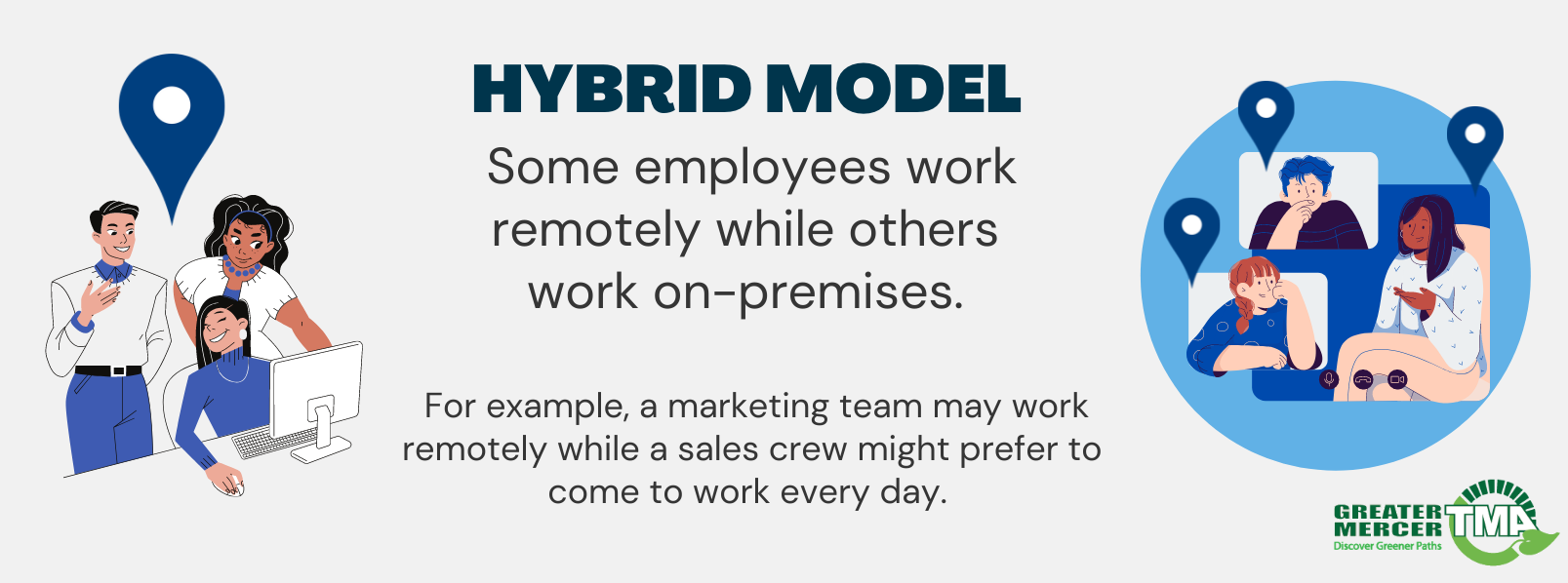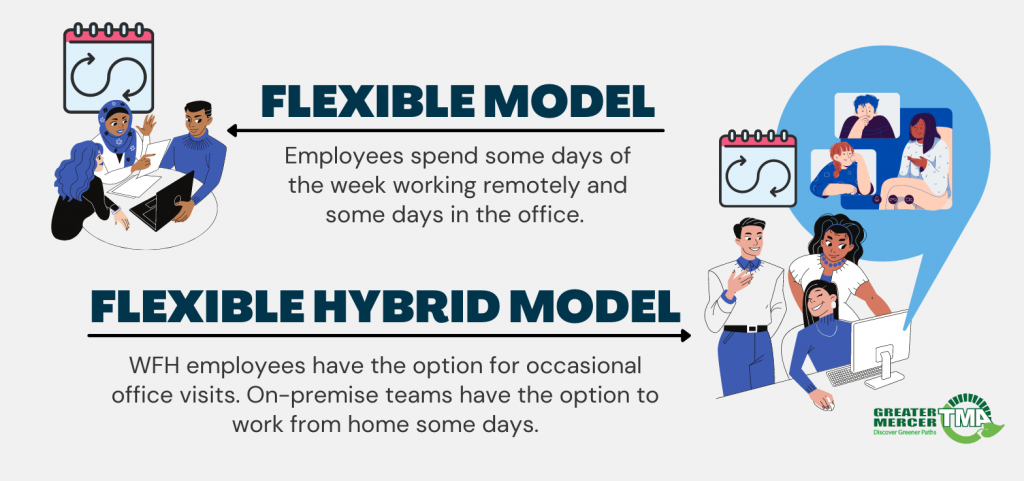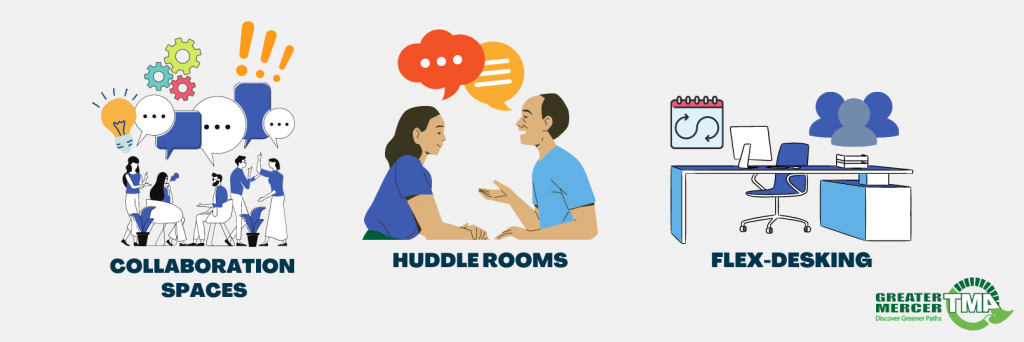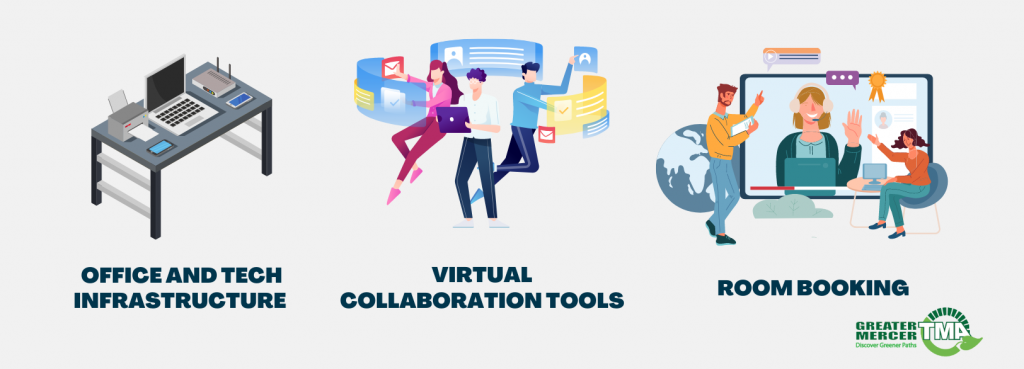Commuting and Flexible, Hybrid Work in Mercer and Ocean County
Businesses are turning to permanent hybrid work-from-home (WFH) models to allow their teams to adapt effortlessly to rapidly changing times. Here are our tips on how to optimize it for your company.
March 2020 changed the notion of work completely when companies all over the world had to allow their employees to work from home through the COVID-19 pandemic. This also greatly reduced peoples’ need to drive or commute to work. Two years later, after many attempts to return to the office, businesses are now considering establishing flexible hybrid work options for their employees, including downsizing offices, and reducing parking spaces.
If you’re not sure what a hybrid WFH model or what a flexible model is, this article will help you define it and understand the benefits. We also talk about different strategies that may help different types of businesses.
What is hybrid work model? What is a flexible work model?

As defined by WeWorkRemotely, a hybrid WFH model “allows some employees to work remotely while others work on-premises.” A hybrid WFH model allows teams or departments to work off-site while others to work in-office. For example, a marketing team may work remotely while a sales crew might prefer to come to work every day.
A flexible model means that employees spend some days of the week working remotely and some days in the office.

A combination of the two, or flexible hybrid model, requires classifying employees as WFH or on-premise workers. WFH employees spend most days working remote while having the option for occasional office visits to collaborate, and on-premise teams mostly work in office while having the option to work from home some days.
Benefits of a Hybrid Work Model
Employers, employees, and communities can all benefit from offices adopting a flexible, hybrid work model. Employers may enjoy the flexibility of recruiting from a larger talent pool, decreased overhead costs, and more. Employees also save on transportation-related expenses and can cut down on hours spent commuting. With less people on the road, communities enjoy improved air quality and decreased traffic congestion.

EMPLOYER BENEFITS:
- Improves ability to recruit and retain employees
- Reduces office and parking space requirements
- Decreases company carbon footprint
- Reduces employee absences
- Increases productivity
EMPLOYEE BENEFITS:
- Reduces travel time and stress
- Increases productivity
- Improves work/ life balance
- Reduces personal costs
COMMUNITY BENEFITS:
- Reduces traffic congestion
- Reduces office and parking space requirements
- Reduces air pollution
- Decreases gas consumption
What can help?
No two people experience the hybrid and flexible model the same way, so managers must be ready for customization. Some companies still benefit from having on-site staff, and many workers experience improved productivity and balance when they’re working remotely. If managers can provide adequate safety precautions for on-site staff and ample avenues for collaboration for both in-person and remote workers, business can still run profitably and efficiently in quickly changing times.
Here are some ideas that may help your teams adapt to the new normal:
Plan for different purposes – The new normal of remote work makes in-person work and collaboration all the more special and intentional— people and teams will only gather if the activity is something that simply cannot be done virtually. Have multiple types of workspaces for different activities, and allow team members to find the best spaces for what they need to get done.

Collaboration and meeting spaces – If your team typically works remotely and decides to come to the office for a day or two, it’s important to have ample space and facilities to support this type of special activity. Consider having larger rooms designed for collaboration and design thinking— whiteboards, presentation spaces, and supplies for brainstorming.
Huddle rooms and small meeting spaces– Conversely, your office may also want to have spaces for one-on-one conversations or campfire discussions for smaller teams and meetings.
Room booking – When working with hybrid teams (some work remote and some work on-site), meeting rooms should also come equipped with a room booking system. Room booking systems allow on-site workers to quickly and easily start meetings with remote workers dialing into the room. This reduces time and effort spent setting up meetings every time and minimizes the amount of time wasted waiting between meetings.
Flex-desking – This is when employees book desks each morning they come into the office. This allows hybrid workers to use desks when they need them and allows other employees to use them other times. This maximizes utility and resource usage. If employees are in the office at different times, you may not always need a 1:1 system for workers and desks.

Office and tech infrastructure – For remote workers, make sure to provide them all the equipment they will need. Whether it’s a laptop, headset and mic, or phone, don’t expect employees to provide their own devices just to work remotely.
Virtual collaboration tools – Before adopting a flexible or hybrid work setup, you must have the tech tools ready to help manage tasks, keep track of progress, and maintain communication. For example, Trello boards help with project management, assigning tasks and progress tracking; Scrum software helps manage all the team’s workflow; and Google Docs allows real-time collaboration among users.
Final Thoughts
The hybrid work model provides many benefits for the commuter, for the business, and for the environment. However, it requires flexibility, compromise, and adjustments. Traditional work setups and remote work setups each have their pros and cons, and in the post-pandemic world, the hybrid work setup can be a viable solution for many companies. Adopting flexible and hybrid work models is no longer just a survival tactic, but a real way to bring out the best in people.
With these tips in mind, you’ll be able to create harmony between all your team and worker types, no matter where they’re located.
If you should require assistance or have any feedback, please contact us at tma@gmtma.org or give us a call at (609) 452-1491.
Sources:
https://builtin.com/remote-work/hybrid-work-model
https://envoy.com/blog/what-is-a-hybrid-work-model/
https://manilarecruitment.com/manila-recruitment-articles-advice/hybrid-work-setup/
https://www.npr.org/2021/09/03/1034133768/hybrid-work-setup-tips
https://robinpowered.com/blog/workplace-remote-hybrid-employees
https://weworkremotely.com/hybrid-wfh-work-model-here-s-how-to-make-it-work

